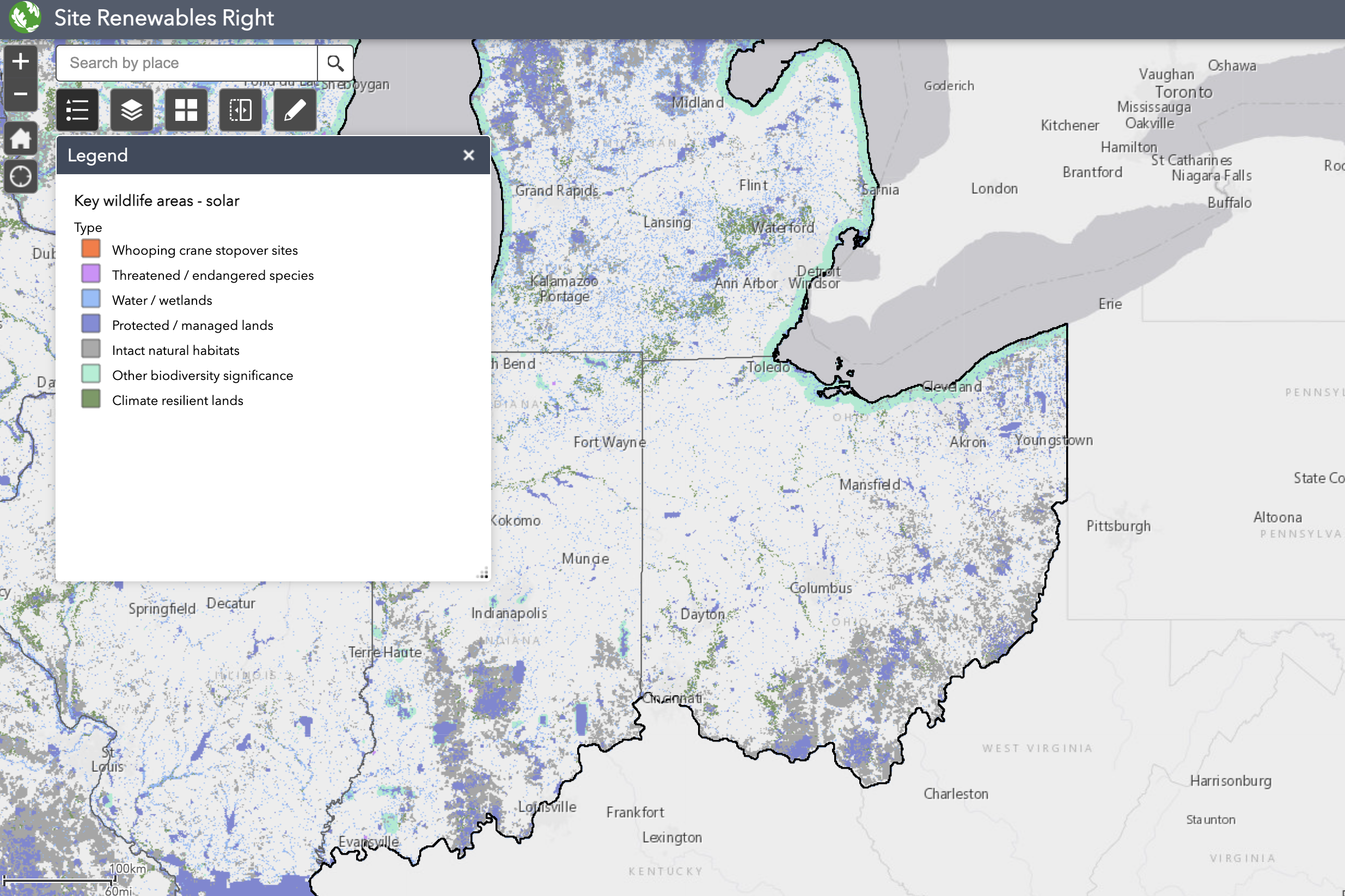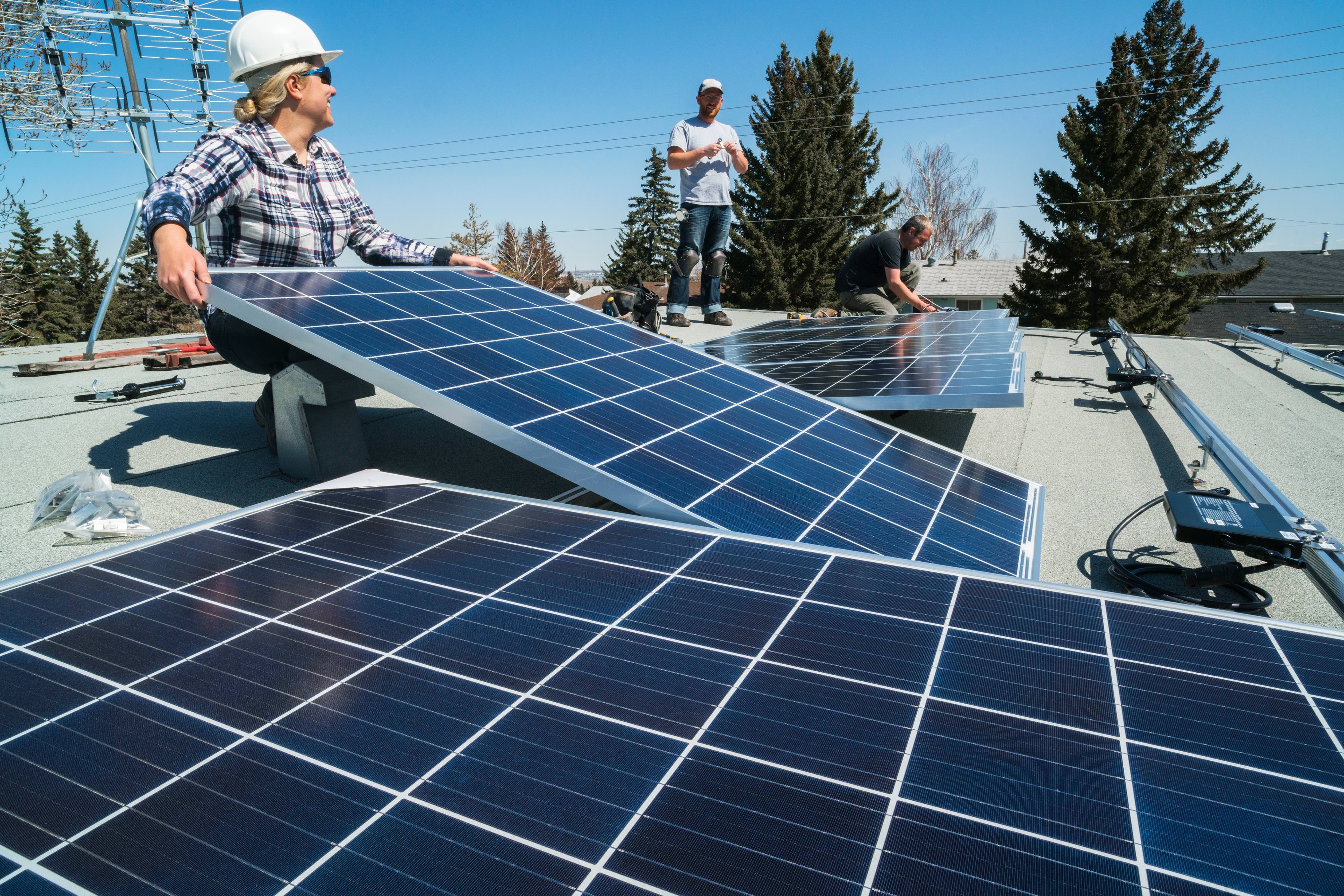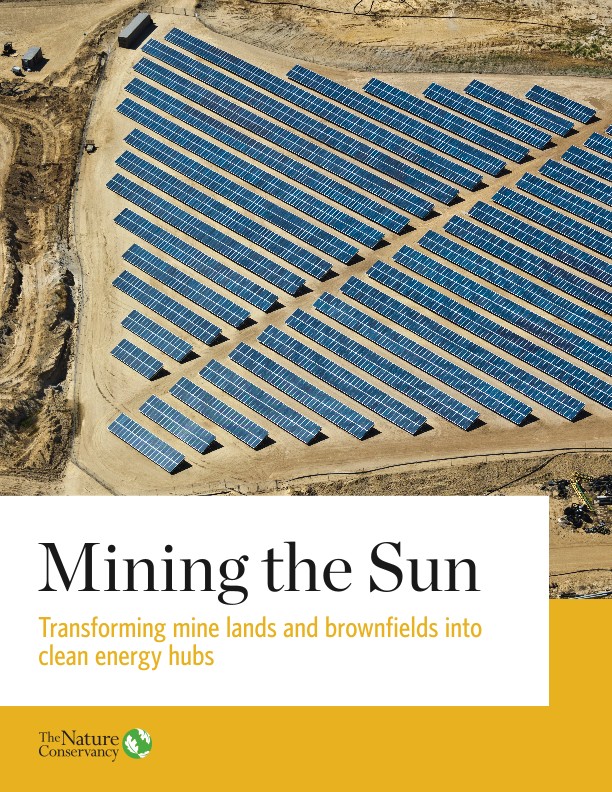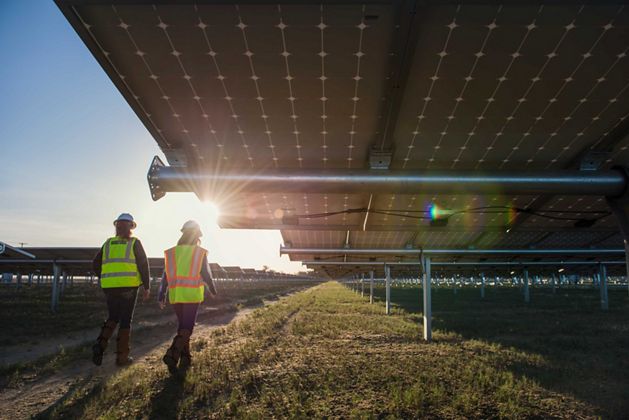Creating a Clean Energy Future in Ohio
TNC is helping to create a renewable energy future in Ohio that benefits the economy and reduces impacts to nature. Discover how we're doing it.
Making the Shift to Clean Energy
Climate change is creating imminent threats to people and nature, including rising sea levels, ecosystem collapse and more frequent severe weather events that weaken the power grid and disproportionately affect economically disadvantaged communities. Shifting to a clean energy future is critical for mitigating these threats caused by rising global temperatures and creating a climate-friendly future for Ohio.
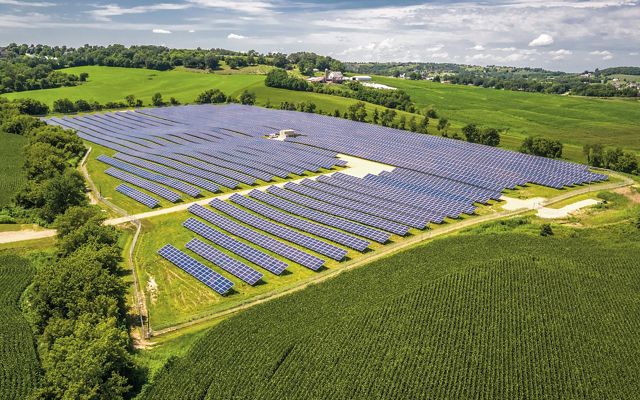
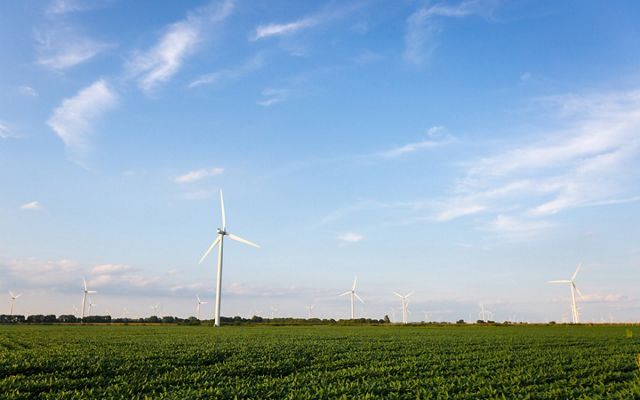
Support a Clean Energy Future in Ohio
DONATE NOWAdvances in wind and solar energy development are helping us make the shift toward renewable energy—a shift that will help us meet carbon reduction goals and curb the most severe threats from climate change. While wind and solar energy projects often require a physical footprint larger than coal, their clean power generation supports a healthy environment for surrounding communities.
To achieve a lower-carbon future in the U.S., research estimates that the necessary wind and solar energy infrastructure will require a footprint 2.5 times the size of the Great Lakes. But Earth’s converted lands, or those that have been previously developed and now remain as unproductive brownfields, can provide the needed area to meet clean energy demand at a level many times over what’s required to reach TNC's climate goals in Ohio.
Clean Energy Benefits the Community
What’s good for nature is also good for people. Moving toward a clean energy economy will not only benefit natural areas and the plants and animals that depend on them, but it will also help bolster Ohio’s economy.
Renewable energy represents one of the fastest-growing job sectors in the U.S. From 2020 to 2021, energy jobs across the nation grew 4%, outpacing overall job employment growth, which climbed 2.8% during that same period. Investments in clean energy will help create thousands of new job opportunities every year in Ohio, with benefits that are expected to ripple throughout the supply chain and broadly across the economy.
Ohio Voters Support the Shift to Clean Energy
In a 2017 poll of Ohio voters, the vast majority supported the idea of paying more for electricity if it meant more wind and solar energy. A more recent 2021 study showed broad Ohio voter support for passage of the Infrastructure Investment and Jobs Act, which will help fund clean energy development across the nation, including a pilot program for renewable energy projects on former mine land.
Ohio Voters Support the Move to Clean Energy
-
53%
Ohio voters that say a majority of the state’s power should come from renewables
-
92%
Ohio voters that are willing to pay more per month for renewable energy
-
55%
Ohio voters that prefer to mandate that utilities increase renewable energy use, rather than offering voluntary programs
Ohio's Businesses Commit to Carbon Emissions Reductions and Renewable Energy
Ohio’s top 80 employers show similar support, with the majority expressing sustainability commitments that highlight some degree of carbon emissions reduction and/or renewable energy goals.
Passage of the Inflation Reduction Act in 2022 will further boost Ohio's renewable energy job sector by providing an estimated $12.8 billion of investment in large-scale clean power generation and storage between now and 2030. Funding from the act will also support a diversity of tax credits for residential and commercial renewable energy projects and incentivize drivers to make the switch to electric vehicles.
Ohio Businesses Are Transitioning to Clean Energy
-
77%
Percentage of top 80 employers that have either renewable energy or greenhouse gas and/or carbon emission reduction goals
-
2040
Average year Ohio's top 80 employers hope to achieve renewable energy target goals
-
72%
Average goal for renewable energy usage among Ohio's top 80 employers
Clean Energy with Conservation in Mind
Despite sluggish adoption of clean energy policy in the U.S., TNC is helping to bridge the gap between conservation of natural areas and the demands of a clean energy economy while also advocating for legislative action that will support both. We are using the power of nature and the strength of policy and markets to reduce emissions, support renewable energy and store carbon to reach our global goal of avoiding or sequestering 3 billion metric tons of carbon dioxide emissions each year by 2030.
Achieving the clean energy build-out necessary to meet our climate goals will require quadrupling our renewable energy capacity in the United States by 2050. Up to 75% of the nation’s new large renewable energy projects will occur in the central U.S., home to much of the nation’s most promising wind and solar resources. This area of the U.S. is also home to much of the nation’s most productive farmland and important natural areas that support wildlife.
Over 44% of Ohio is prime agricultural land, and around 30% is forested. Avoiding conflict with these areas is an important part of building a clean energy future. To help accomplish this, TNC is helping to identify ideal areas for wind and solar energy development through mapping projects like Site Renewables Right and Mining the Sun. These tools will help developers steer clean energy projects toward lands like brownfields and former mines and away from natural areas like forests and areas where high impact to wildlife might occur.
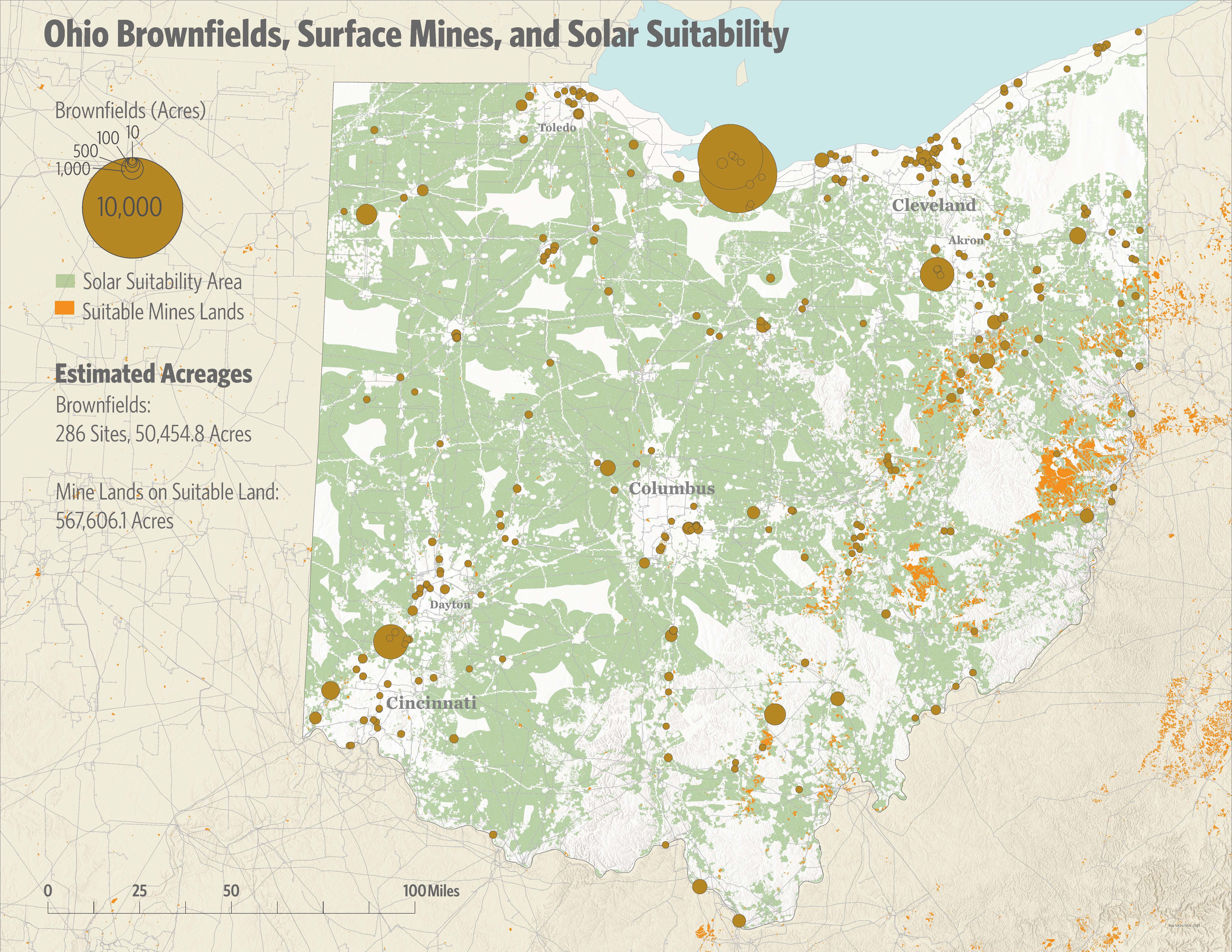
Mining the Sun
The Environmental Protection Agency estimates that more than 43 million acres of brownfields and former mine lands could be suitable for solar energy infrastructure. In Ohio alone, there are nearly 300 brownfield sites amounting to more than 50,000 acres and an additional 567,600 acres of formerly mined lands that have access to transmission lines and are suitable to consider for solar development. Prioritizing solar siting on these previously disturbed lands helps steer energy development away from forests, farmland and other important areas for clean water, wildlife, carbon sequestration and nature-based tourism and recreation. As an added benefit, brownfields of former industrial operations offer existing infrastructure including access roads and powerlines, further reducing the cost of development and the likelihood of habitat destruction.
Download
Repurposing mines and brownfields for clean energy can reduce costs, accelerate the clean energy transition and protect wildlife.
DOWNLOADQuote: Rebecca Mellino
Our mapping tools are helping developers make informed decisions about where to place renewable energy sites like solar and wind farms in ways that reduce the impact to nature and wildlife and are mindful of community reception.
Creating a Carbon-Neutral Future for Ohio
The best energy planning pathway is one that recognizes the power of place—a strategic approach to planning for clean energy with land conservation in mind. It’s not only possible but critical to the health of the planet that the world reaches its climate goals quickly while minimizing impacts to the environment.
Power of Place
The United States needs to build an unprecedented amount of clean energy to reduce carbon emissions by 2050. Power of Place lays out a vision and recommendations that steer energy planners and policymakers towards thoughtful net-zero strategies that benefit climate, conservation, and communities. Launched in May 2023, this new Power of Place study provides a roadmap for Ohio and other U.S. states to ensure that clean energy and conservation goals align.
Renewable Energy at Our Preserves
Here at TNC, we believe strongly in reducing our own environmental impact. That's why we're incorporating emissions-reductions measures at our own preserves. In 2021 TNC launched a nationwide partnership with Rivian, a U.S.-based electric vehicle company. Rivian is helping TNC develop a nationwide network of EV chargers on our preserves, including at our very own Grand River Conservation Campus in Ashtabula County. And through a donation from Third Sun Kokosing Solar, new solar panels were installed on the pavilion next to our Dr. James K. Bissell Nature Center at the Campus. The 7.4 kW solar panels will help to power the campus’ pavilion lights, the nature center and our electric vehicle charging stations.

Learn More About Our Renewable Energy Work
-
Site Renewables Right
Achieving the clean energy build-out necessary to meet our climate goals will require quadrupling our renewable energy capacity in the United States by 2050. Learn how we're helping to identify sites for renewable buildout.
-
Contact
Have questions about our work with renewable energy in Ohio? Email us today! Contact Us



